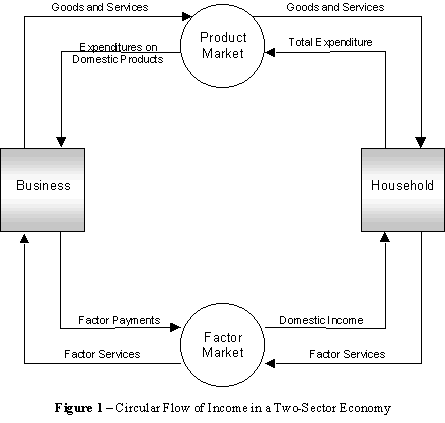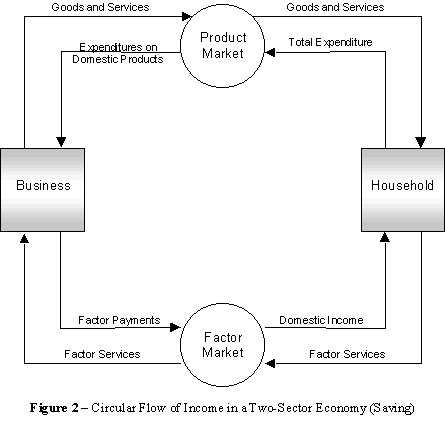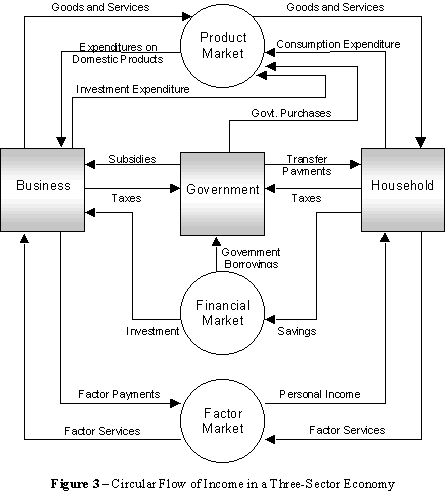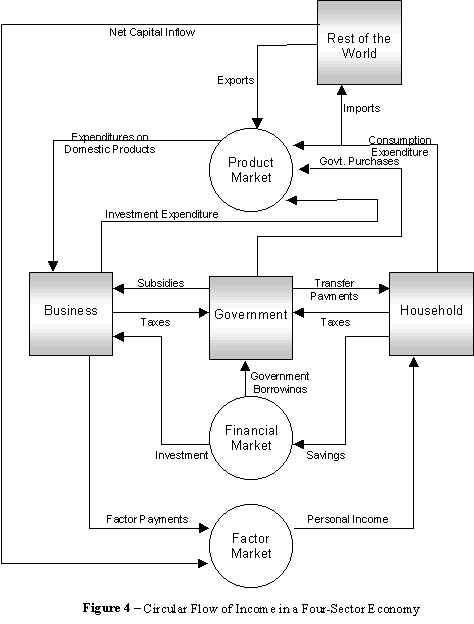
The amount of income generated in a given economy within a period of time (national income) can be viewed from three perspectives. These are:
· Income,
· Product, and
· Expenditure.
The
above assertion implies that we can view national income as either the total sum
of all income received within a particular period (income); the total good and
services produced within a particular period (product) or total expenditure on
goods and services within a given period (expenditure).
Whichever approach is used, the value we get is the same.
The circular flow of income and product is used to show diagrammatically, the equivalence between the income approach and the product approach in measuring gross national product (GNP).
In
analysing the circular flow of income, there are three scenarios:
1.
A simple and closed economy with no government and external transactions,
i.e., two-sector economy;
2.
A mixed and open economy with savings, investment and government
activity, i.e., three-sector economy; and
3.
A mixed and open economy with savings, investment, government activity
and external trade, i.e., four-sector economy.
1. Circular Flow of Income in a Two-Sector Economy:
According to
circular flow of income in a two-sector economy, there are only two sectors of
the economy, i.e., household sector and business sector.
Government does not exist at all, therefore, there is no public
expenditure, no taxes, no subsidies, no social security contribution, etc.
The economy is a closed one, having no international trade relations. Now we will discuss each of the two sectors:
(i)
Household
Sector: The household sector is the
sole buyer of goods and services, and the sole supplier of factors of
production, i.e., land, labour, capital and organisation.
It spends its entire income on the purchase of goods and services
produced by the business sector. Since
the household sector spends the whole income on the purchase of goods and
services, therefore, there are no savings and investments.
The household sector receives income from business sector by providing
the factors of production owned by it.
(ii)
Business
Sector: The business sector is the sole
producer and supplier of goods and services.
The business sector generates its revenue by selling goods and services
to the household sector. It hires
the factors of production, i.e., land, labour, capital and organisation, owned
by the household sector. The
business sector sells the entire output to households.
Therefore, there is no existence of inventories.
In a two-sector economy, production and sales are thus equal.
So long as the household sector continues spending the entire income in
purchasing the goods and services from the business sector, there will be a
circular flow of income and production. The
circular flow of income and production operates at the same level and tends to
perpetuate itself. The basic
identities of the two-sector economy are as under:
Y
= C
Where Y is Income
C is Consumption

Circular
Flow of Income in a Two-Sector Economy (Saving Economy):
In a two-sector macro-economy, if there is saving by the household sector out of its income, the goods of the business sector will remain unsold by the amount of savings. Production will be reduced and so the income of the households will fall. In case the savings of the households is loaned to the business sector for capital expansion, then the gap created in income flow will be filled by investment. Through investment, the equilibrium level between income and output is maintained at the original level. It is illustrated in the following figure:

The equilibrium condition for two-sector economy with saving is as follows:
Y =
C + S
or
Y = C + I
or
C + S = C + I
or
S = I
Where Y is Income
C is Consumption
S is Saving
I
is
Investment
When
saving and investment are added to the circular flow, there are two paths by
which funds can travel on their way from households to product markets. One path
is direct, via consumption expenditures. The other is indirect, via saving,
financial markets, and investment.
Savings:
On the average, households spend less each year than they receive in income. The
portion of household income that is not used to buy goods and services or to pay
taxes is termed ‘Saving’. Since
there is no government in a two-sector economy, therefore, there are no taxes in
this economy.
The
most familiar form of saving is the use of part of a household’s income to
make deposits in bank accounts or to buy stocks, bonds, or other financial
instruments, rather than to buy goods and services. However, economists take a
broader view of saving. They also consider households to be saving when they
repay debts. Debt repayments are a form of saving because they, too, are income
that is not devoted to consumption or taxes.
Investment:
Whereas households, on the average, spend less each year than they
receive in income, business firms, on the average, spend more each year than
they receive from the sale of their products. They do so because, in addition to
paying for the productive resources they need to carry out production at its
current level, they desire to undertake investment.
Investment
includes all spending that is directed toward increasing the economy’s stock
of capital.
Financial
Market:
As we have seen, households tend to spend less each year than they receive in
income, whereas firms tend to spend more than they receive from the sale of
their products. The economy contains a special set of institutions whose
function is to channel the flow of funds from households, as savers, to firms,
as borrowers. These are known as
‘financial
markets’.
Financial markets are pictured in the center of the circular-flow diagram in the
above figure.
Banks
are among the most familiar and important institutions found in financial
markets. Banks, together with
insurance companies, pension funds, mutual funds, and certain other
institutions, are termed ‘financial
intermediaries’, because
their role is to gather funds from savers and channel them to borrowers in the
form of loans.
2.
Circular Flow of Income in a Three-Sector Economy:
We have so
far discussed the two-sector economy consisting of household sector and business
sectors. Under three-sector
economy, the additional sector is the government.
Two-sector economy is a hypothetical economy, whereas the three-sector
economy is much more realistic. The
inclusion of the government sector is very essential in measuring national
income. The government levies taxes
on households and on business sector, purchases goods and services from business
sector, and attain factors of production from household sector.
The following figure illustrates three-sector economy:

In the above diagram, in one
direction, the household sector is supplying factors of production to the factor
market. Business sector demands the
factors of production from factor market. Inputs
are used by the business sector, which produces goods and services that are
purchased back by the households and the government.
Personal income after tax or disposable income that is received by
households from business sector and government sector is used to purchase goods
and services and makes up consumption expenditure (or C).
The money spent in the product market is the market value of final goods
and services (or GDP). That money
goes to business sector that pays it back in the form of wages, rent, profits
and interests.
Total spending on goods and services
is known as ‘aggregate demand’.
The total market value of output produced and sold is also known as ‘aggregate
supply’. To measure aggregate
demand in a closed economy, we simply add consumption spending (C), investment
spending (I) and government spending (G). Therefore:
Y = C + I + G
Where Y is Income,
C is Consumption,
I is Investment, and
G is Government Spending.
Note that government spending (G)
includes its buying of labour from factor market, buying of goods and services
from product market, and transfer payments to the household sector.
Transfer payments are payments the government makes in return for no
service, for example, welfare payments, unemployment compensation, pension, etc.
The government collects its money in the form of tax, which makes up most
of the government revenue. But the
government does not always balance their budgets. The government always tends to spend more than it takes in as taxes.
The federal government almost always runs a deficit.
The government deficit must be financed by borrowing in financial
markets. Usually this borrowing takes the form of sales of government bonds and
other securities to the public or to financial intermediaries.
Over time, repeated government borrowing adds to the domestic debt.
The ‘debt’
is a stock that
reflects the accumulation of annual ‘deficits’,
which are flows.
When the public sector as a whole runs a budget surplus, the direction of
the arrow is reversed. Governments pay off old borrowing at a faster rate than
the rate at which new borrowing occurs, thereby creating a net flow of funds
into financial markets.
3.
Circular Flow of Income in a Four-Sector Economy:
Two-sector economy and three-sector economy are briefly discussed in previous sections. These are hypothetical economies. In real life, only four-sector economy exists. The four-sector economy is composed of following sectors, i.e.:
(i) Household sector,
(ii) Business sector,
(iii) The government, and
(iv)
Transaction with ‘rest of the world’ or foreign sector or
external sector.
The household sector, business sector
and the government sector have already been defined in the previous sections.
The foreign sector includes everyone and everything (households,
businesses, and governments) beyond the boundaries of the domestic economy. It
buys exports produced by the domestic economy and produces imports purchased by
the domestic economy, which are commonly combined into net exports (exports
minus imports). The inclusion of
fourth sector, i.e., foreign sector or transaction with ‘rest of the
world’ makes the national income accounting more purposeful and realistic.
With the inclusion of this sector, the economy becomes an open economy. The transaction with ‘rest of the world’ involves
import and export of goods and services, and new foreign investment.
It is illustrated in the following figure.

In
four-sector economy, goods and services available for the economy’s purchase
include those that are produced domestically (Y) and those that are imported
(M). Thus, goods and services available for domestic purchase is Y+M.
Expenditure for the entire economy include domestic expenditure (C+I+G) and
foreign made goods (Export) = X. Thus:
Y
+ M = C + I + G + X
Y
= C + I + G + (X – M)
Where, C = Consumption expenditure
I = Investment spending
G = Government spending
X = Total Exports
M = Total Imports
X – M
= Net Exports
Economy
Leakages and Injections:
Leakages:
When households engage in savings and purchase of goods and services from
abroad, we experience temporary withdrawal of funds from circulation.
Therefore, leakages in the circular flow are savings, taxes and imports
Injection:
On the other hand, when we sell abroad (export) we receive income.
More so when foreigners invest in our country the level of income will
also increase. These two activities
are injection into the income stream. Therefore,
injections are investment, government spending and exports.
Total
Leakages
=
Total Injections
C
+ I + G + (X-M) = C + S + Net Taxes
S
+ Net Taxes + Imports = I + G + Exports
S
= I + (G – NT) + (X – M)
One way of thinking about the circular flow of income is to imagine a water tank. Investment, government spending and spending by foreigners is injected into the tank, and savings, taxes and spending on imports leak out. The injections and the withdrawals are equal to each other so the level in the tank is stable, or as economists like to say in equilibrium.

If injections are greater than withdrawals or leakages then the level in the tank will rise. If withdrawals are greater than injections then the level in the tank falls. If planned (I+G) is equal to planned (S+T), so that injections is equal to leakages and total spending is equal to total income and total demand is equal to total supply. Then we have a ‘stable economy’. If leakages are higher than injections i.e., planned savings plus taxes are greater than planned investment plus government spending (S+T > I+G), economy contracts resulting in inventory accumulation, too little spending and drop in prices. If injections are higher than leakages, i.e., planned investment plus government spending are greater than planned saving plus taxes (I+G > S+T), economy expands resulting in more goods and services produced, and higher prices.